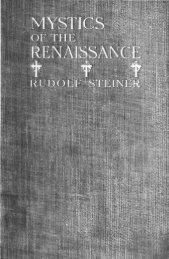The Supreme Doctrine - neo-alchemist
The Supreme Doctrine - neo-alchemist
The Supreme Doctrine - neo-alchemist
You also want an ePaper? Increase the reach of your titles
YUMPU automatically turns print PDFs into web optimized ePapers that Google loves.
ON THE IDEA OF ‘DISCIPLINE’<br />
disappearance of the illusion in which I am living at present of not being in<br />
the state of satori.<br />
If the gesture of instanta<strong>neo</strong>us decontraction prepares the satorioccurrence,<br />
that is because the instanta<strong>neo</strong>us suspension which it obtains in<br />
the unfolding of the imaginary film breaks on each occasion the vicious circle<br />
which exists between our images and our emotions. This vicious circle that<br />
we have called 'imaginative-emotive rumination', which corresponds also<br />
with what we have described as the 'emotive state', or 'inner spasm', or as<br />
'gearing of the affectivity with the intellect', is an inner automatism animated<br />
by a great force of inertia. Our imaginative rumination does not function<br />
continuously with the same effective power, but in each stage of our<br />
evolution it has a certain possibility of power. This possibility is used, mined<br />
little by little by the instants of decontraction. This progressive diminution of<br />
the solidity of the vicious circle of images and emotions is revealed by a<br />
progressive modification of our inner life, of our vision of things in general.<br />
Not that we are able, before satori, to have the least little atom of 'vision of<br />
things as they are'; but our present vision of things-as-they-are-not loses its<br />
clarity, its relief, its colours.<br />
In order to make clear the modifications that the inner work obtains<br />
indirectly in our vision of things we will make use of an illustration. We will<br />
compare our imaginative film with the projection of a cinematographic film<br />
comprising a projector, a screen, and the luminous cone which connects<br />
them. When the projection is well focussed on the screen I see clear images<br />
thereon, in which the blacks and whites are well-contrasted. If, without<br />
changing anything in the projector, I progressively bring the screen nearer to<br />
it, the images will gradually lose their clearness and their contrasts. A<br />
moment will come when I recognise them with difficulty and when the<br />
blacks become grey. <strong>The</strong>n there are nothing but pale and vague shadows<br />
accompanied by an increase in the general luminosity of the screen. Finally,<br />
when I am in contact with the projector, the screen is completely white and<br />
sparkling.<br />
<strong>The</strong> projector here symbolises the original Unconscious or No Mind,<br />
source of our consciousness; the luminous beam symbolises the<br />
subconscious; the screen the consciousness. <strong>The</strong> screen of our consciousness<br />
is set, by our personal egotistical determinism, at the distance at which the<br />
images are in focus. It is there that our claim-to-be-distinct fixes our<br />
attention. That corresponds with the partial inner attitudes by which I oppose<br />
195




